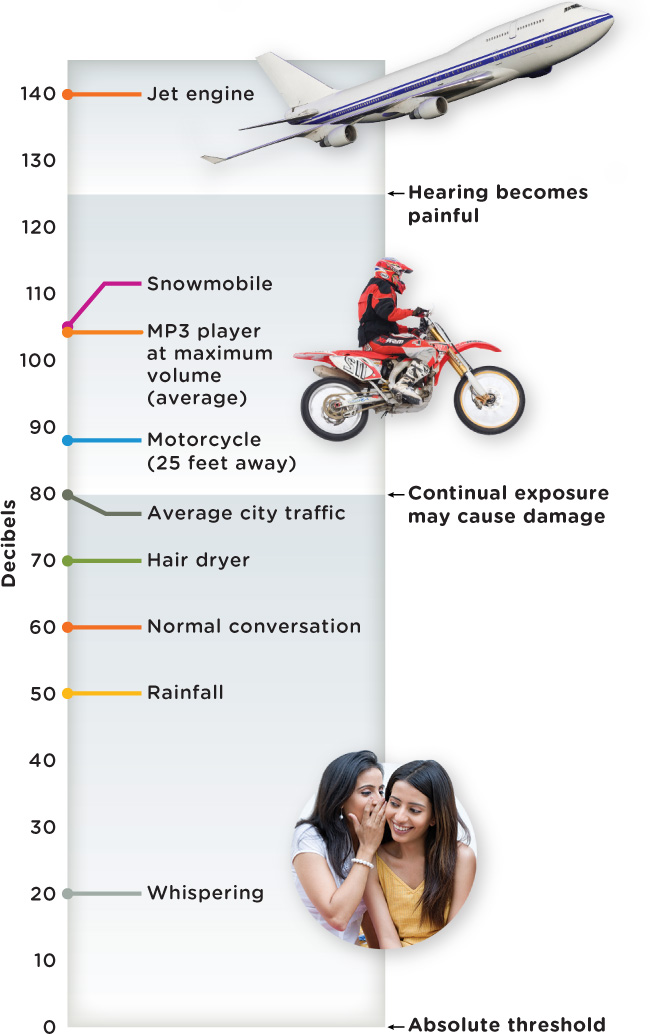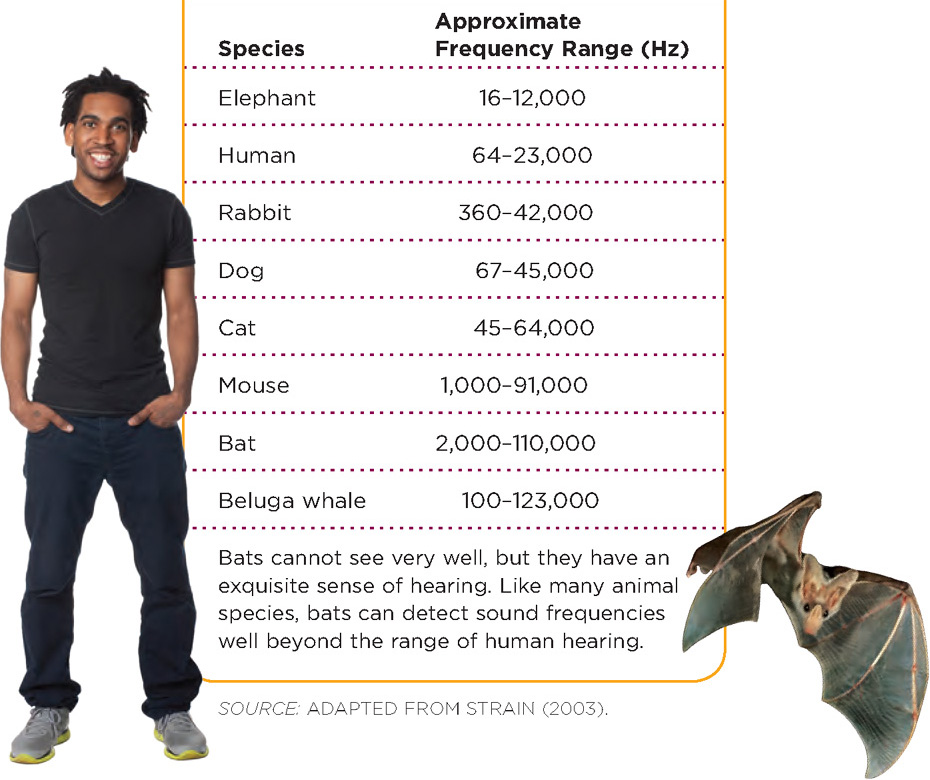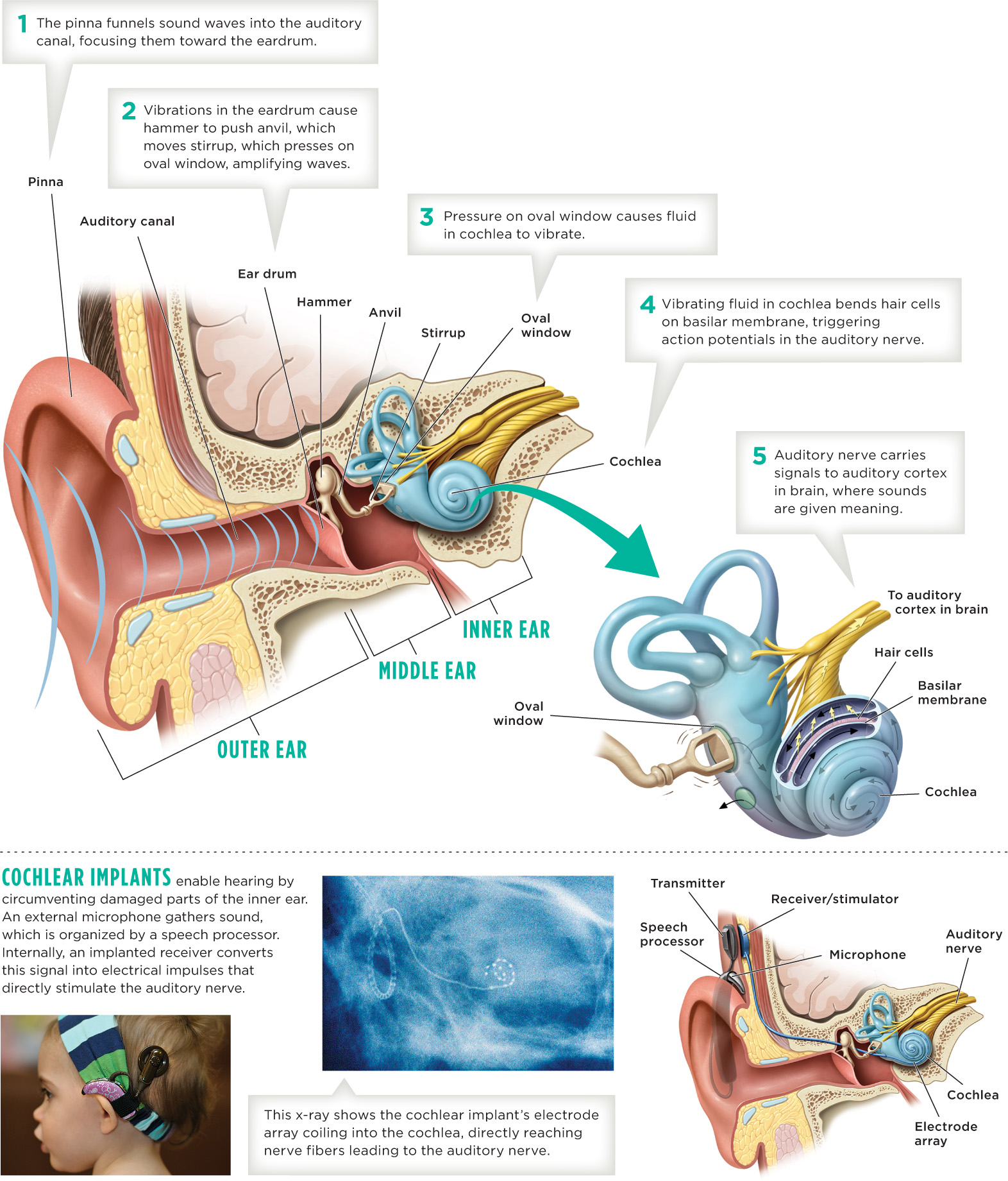3.3 Hearing
THE EARS OF THE TRIPLETS
 Taking care of three blind infants and a preschooler was no easy task, but Liz was strong, stubborn, and determined to see her girls thrive. And the triplets did thrive. By 20 months, they were beginning to reach the major developmental milestones of babyhood: walking and talking. But just as they were beginning to take their first steps and say their first words, “cup” and “Mama,” everything fell apart.
Taking care of three blind infants and a preschooler was no easy task, but Liz was strong, stubborn, and determined to see her girls thrive. And the triplets did thrive. By 20 months, they were beginning to reach the major developmental milestones of babyhood: walking and talking. But just as they were beginning to take their first steps and say their first words, “cup” and “Mama,” everything fell apart.
It started with Zoe, who out of the blue stopped playing with her favorite toy, a cube that made different sounds when she pushed on its sides. Zoe would push the buttons over and over, then burst into tears. Eventually, Zoe and her sisters stopped responding to Liz’s voice. Hearing had been the main portal connecting the triplets to the outside world. It allowed them to communicate their needs to Liz, babble among themselves, and take pleasure in music. But now that door had closed, too.

It was also during this period that the triplets began to act as if they had some kind of stomach illness—refusing to eat, vomiting during car rides, curling up in the fetal position, and banging their heads against the floor. These were not the symptoms of a tummy ache, but something much more troubling: vertigo, a dizzying sensation of spinning or whirling.
Both conditions—the deafness and the vertigo—arose from deterioration of the inner ear, home to the delicate structures responsible for hearing and balance. The damage dated back to the triplets’ first few months in the hospital when doctors had given them antibiotics. The drugs may have saved the girls’ lives, but they had a devastating side effect: ototoxicity, or “ear poisoning.”
Listen, Hear
LO 7 Summarize how sound waves are transduced into the sensation of hearing.
The wind howling. A baby crying. Raindrops pelting the roof of the car. These sounds are perceived so differently, yet they all begin with the same type of stimulus: a sound wave moving through the environment. When we use our sense of hearing, or audition, we are detecting sound waves that enter our ears. Sound waves are the rhythmic vibrations of molecules traveling through a variety of forms of matter, such as air. Sound waves can also travel through materials like water, metal, and wood, which is why we can hear muffled sounds through the walls in an apartment or when swimming. Where do these sound waves originate?
Sound Waves
Every sound wave begins with a vibration. That could mean a pulsating loud speaker, a quivering guitar string, or vocal chords fluttering in your throat. When an object vibrates, it sends a pressure disturbance of molecules moving through the air. Imagine a very quiet environment, such as late at night in a parked car; the molecules in the air in the car for the most part are evenly distributed. If you were to turn on the radio with its amplified speakers, the speaker’s membrane would immediately bulge outward, pushing air particles out of its way. This creates a zone where the particles are tightly packed and the pressure is high; the particles directly in front of the speaker will hit the particles right in front of them, and so on throughout the interior of your car. As the speaker retracts, or pulls back, it gives the air particles ample room to move, creating a zone where particles are spread out and pressure is low. As the speaker rhythmically pushes back and forth, it sends cycles of waves of high pressure (with particles “bunched up”) and low pressure (with particles “spread out”) rippling through the air (Ludel, 1978). It’s important to note that molecules are not being transmitted when you speak to a friend across the room; air particles from your mouth do not travel to his ears, only the sound wave does.
Now that we have established what sound waves are—alternating zones of high and low pressure moving through the environment—let’s address the immense variation in sound quality. Why are some noises loud and others soft, some shrill like a siren and others deep like a bullfrog? Sounds can be differentiated by three main qualities: loudness, pitch, and timbre.
Loudness
Let’s begin by exploring loudness. We sense the loudness of a sound based on the amplitude, or height, of the wave it generates. A kitten purring generates low-amplitude sound waves; a NASCAR engine generates high-amplitude sound waves. Just remember: The taller the mound, the louder the sound. Loudness is measured in decibels (dB), with 0 dB being the absolute threshold for human hearing; normal conversation is around 60 dB. Noises at 140 dB can be instantly detrimental to hearing (Yost, 2007). But you needn’t stand next to a 140-dB jet engine to sustain hearing loss. Prolonged exposure to moderately loud sounds such as traffic and loud music can also cause damage. Think twice the next time you crank up the volume on your iPod. Figure 3.2 illustrates sound levels, some of which are capable of causing auditory damage.

Pitch
The pitch of a sound describes how high or low it is. An example of a high-pitched sound is a flute at its highest notes; a low-pitched sound is a tuba at its lowest notes. The pitch of a sound is based on the frequency of its waves. We measure frequency with a unit called the Hertz (Hz), which indicates the number of wave peaks passing a given point in 1 second. A higher-pitched sound, like the high note of a flute, will have a higher frequency of waves; the time between the “bunched up” particles and the “spread out” particles will be less than that for the lower-pitched sound of a tuba. If you are hearing a 200-Hz sound wave, then theoretically 200 waves enter your ear per second. Humans can detect frequencies ranging from about 20 Hz to 20,000 Hz, but we tend to lose the higher frequencies as we get older. TABLE 3.2 shows the range of frequencies that can be detected by humans and other species. And just remember, the faster the peaks, the higher the squeaks, and if waves are slow, the pitch is low.

When Emma, Zoe, and Sophie began to go deaf, they lost their ability to hear high frequencies first, which means they stopped hearing high-pitched sounds, like female voices, before they lost the ability to detect deeper sounds. It pains Liz to reminisce about this period because she wonders how her babies felt when it seemed like their Mom had stopped talking to them.
People with normal hearing can generally tell the difference between high and low pitches, but singing notes on key is quite a different story. If you’ve ever been to a karaoke club, you know that plenty of people cannot carry a tune to save their lives. Why is this so?
from the pages of SCIENTIFIC AMERICAN
Physically Out of Tune
Poor muscle control, not aural perception, underlies most cases of bad singing
A cringe-worthy chorus of “Happy Birthday” is usually all it takes to earn the label of “tone-deaf.” Yet fewer than 1 percent of the population is truly amusical, that is, lacking the ability to distinguish different pitches. Many more of us simply can’t carry a tune. A study published online in the Journal of Experimental Psychology: General reinforces scientists’ growing belief that the culprit is not the ear but the throat. In a series of pitch-matching experiments, nonmusicians were pretty good at adjusting an instrument to match a specific note, suggesting that they could hear it just fine. They had much more trouble, however, imitating the same note with their own voice. The authors suspect that poor motor control of vocal muscles is partly to blame—findings that reinforce the idea that almost anyone can learn to sing. Lena Groeger. Reproduced with permission. Copyright © 2012 Scientific American, a division of Nature America, Inc. All rights reserved.
Timbre
We know that sounds can have different levels of loudness and pitch, but how is it possible that two sounds with identical loudness and pitch (Beyonce and Shakira belting the same note at the same volume) can sound so different? The answer to this question lies in the timbre. The texture of a sound, or timbre, describes its unique combination of frequencies. Most of the “racket” you hear on a regular basis—people’s voices, traffic noises, humming air conditioners—is made up of many frequencies. Timbre is the reason we can tell the difference between two sounds with exactly the same pitch and loudness.
All Ears
We have outlined the basic properties of sound. Now let’s learn how the ears transform sound waves into the language of the brain. As you will see, your ears are extraordinarily efficient at what they do—transducing the physical motion of sound waves into the electrical and chemical signals of the nervous system (Infographic 3.3).
From Sound Wave to Bone Movements
What exactly happens when a sound wave reaches your ear? First it is ushered inside by the ear’s funnel-like structure. Then it sweeps down the auditory canal, a tunnel leading to a delicate membrane called the eardrum, which separates the outer ear from the middle ear. The impact of the sound wave bouncing against the eardrum sets off a chain reaction through the three tiny bones in the middle ear: the hammer, anvil, and stirrup. The chain reaction of the tiny bones moving each other amplifies the sound wave, turning it into a physical motion that has great strength. The hammer pushes the anvil; the anvil moves the stirrup; and the stirrup presses on a drum-like membrane called the oval window leading to the ear’s deepest cavern, the inner ear. It is in this cavern that the amazing transduction occurs, eventually registering in the brain as sound.
From Bone Movement to Moving Fluid
The oval window marks the boundary to the inner ear. The cochlea (kō-klē-ə), a snail-shaped structure filled with liquid, is the primary component of the inner ear. It is also the place where the auditory receptors are. These cells take the information conveyed by the sound and transform it into neural messages: (1) The sound waves hit the eardrum, (2) which starts the vibrations of the tiny bones, (3) causing fluid in the cochlea to vibrate as well. Let’s take a closer look at what is occurring inside the cochlea.
The entire length of the cochlea is lined with the basilar membrane, which contains about 16,000 hair cells. These hair cells are the receptor cells for the sound waves, which have been transformed into liquid waves. When the fluid in the cochlea moves, the hair cells bend in response to this motion. Below the base of the hair cells are dendrites of neurons whose axons form the auditory nerve (Ludel, 1978). If a vibration is strong enough in the cochlear fluid, the bending of the hair cells causes the nearby nerve cells to fire. Signals from the auditory nerve pass through various processing hubs in the brain, including the thalamus, and eventually wind up in the auditory cortex, where sounds are given meaning.
Cochlear Implants
The cochlea is an extremely delicate structure. If the hair cells are damaged or destroyed, they will not regrow like blades of grass (at least in humans and other mammals). So when Emma, Zoe, and Sophie lost their hearing around age 2, there was no magical drug or surgical procedure that could restore their hearing. Hope arrived about a year later, when the triplets were outfitted with cochlear implants, electronic devices that help those who are deaf or hard-of-hearing. These “bionic ears,” as they are sometimes called, pick up sound waves from the environment with a microphone and turn them into electrical impulses that stimulate the auditory nerve, much as the cochlea would do were it functioning properly. From there, the auditory nerve transmits electrical signals to the brain, where they are “heard,” or interpreted as human voices, hip-hop beats, and dog barks.
Cochlear implants have enabled many people to understand language and appreciate music, but “hearing” with a cochlear implant is not exactly the same as hearing with two ears. Voices may sound computerized or Mickey Mouse-like (Mayo Clinic, 2012, May 11). Liz had no idea how the girls would respond to their first experience hearing with the implants. They reacted the same way they do to most everything in life—each in her own way. Zoe broke into a huge grin; Emma sat still, just listening; and Sophie started crying (Hudson & Paul, 2007).
You might be wondering why the triplets were provided with cochlear implants, not hearing aids. Hearing aids work by increasing the amplitude of incoming sound waves (making them louder) so the hair cells in the inner ear can better detect them. If hair cells are damaged beyond repair, as was the case for Emma, Zoe, and Sophie, then the inner ear cannot pass along messages to the brain. There will be no sensation of hearing, no matter how much you turn up the volume.
INFOGRAPHIC 3.3: Can You Hear Me Now?
Side effects of lifesaving drugs given to the triplets as newborns eventually led to deterioration of the inner ear, home of the delicate structures where vibrations are converted to electrical and chemical signals that the brain understands as sound. Without this conversion, sound waves may enter the ear, but we do not “hear.” Hearing is a process in which stimuli (sound waves) are mechanically converted to vibrations that are transduced to neural messages. If one part of this complicated system is compromised, hearing loss results. In the triplets’ case, cochlear implants provide a sense of sound.

CONTROVERSIES
Conflicted Feelings About Cochlear Implants
SOME DEAF INDIVIDUALS VIEW THEIR DEAFNESS AS A GIFT….
 Cochlear implants are a marvel of modern technology. To take a brain full of silence and fill it with sound—now, that is an accomplishment worth celebrating, right? Not everyone in the deaf community thinks so. Cochlear implants may sound like a “miracle cure” for people with hearing difficulties, but they are not without controversy (Papsin & Gordon, 2007). The deaf community is divided on the issue, with many saying that deafness is not a medical problem that needs to be fixed, but instead is a culture with its own language, literature, art, and educational system (Swanson, 1997). Some individuals view their deafness as a gift and would choose to remain deaf even if given the opportunity to acquire normal hearing (Sparrow, 2005). Sign language bonds the deaf community, and cochlear implants threaten to weaken that bond by assimilating deaf people into the hearing world. The issue becomes particularly prominent in cases involving young children, whose parents are making decisions for them. When it comes to cochlear implants, there is no right or wrong—only choices appropriate for the unique circumstances facing each individual.
Cochlear implants are a marvel of modern technology. To take a brain full of silence and fill it with sound—now, that is an accomplishment worth celebrating, right? Not everyone in the deaf community thinks so. Cochlear implants may sound like a “miracle cure” for people with hearing difficulties, but they are not without controversy (Papsin & Gordon, 2007). The deaf community is divided on the issue, with many saying that deafness is not a medical problem that needs to be fixed, but instead is a culture with its own language, literature, art, and educational system (Swanson, 1997). Some individuals view their deafness as a gift and would choose to remain deaf even if given the opportunity to acquire normal hearing (Sparrow, 2005). Sign language bonds the deaf community, and cochlear implants threaten to weaken that bond by assimilating deaf people into the hearing world. The issue becomes particularly prominent in cases involving young children, whose parents are making decisions for them. When it comes to cochlear implants, there is no right or wrong—only choices appropriate for the unique circumstances facing each individual.
Pitch and the Cochlea
We know how sound waves are transformed into auditory sensations, but there are many types of sounds. How does the brain know the difference between the yap of a Chihuahua and the deep bark of a Rottweiler, or the sweet song of a flute and the bellow of a tuba? In other words, how do we distinguish between sound waves of high and low frequencies? There are two complementary theories that explain how the brain processes pitch.
Place Theory
LO 8 Illustrate how we sense different pitches of sound.
According to place theory, the location of neural activity along the cochlea allows us to sense the different pitches of high-frequency sounds. Hair cells toward the end of the basilar membrane near the oval window vibrate more to higher-frequency sounds. Hair cells toward the opposite end of the basilar membrane vibrate more in response to lower-frequency sounds. The brain determines the pitch of high-frequency sounds by judging where along the basilar membrane neural signals originate.
But, place theory is better at explaining higher-pitch than lower-pitch sounds. Lower-frequency sounds result in vibrations that are more dispersed along the basilar membrane, with a less precise location of movement than higher-pitch sounds. This makes it difficult for the brain to determine the entire range of pitches in this manner.
Frequency Theory
To understand how humans perceive lower pitches, we can use the frequency theory, which suggests it is not where along the cochlea hair cells are vibrating, but how frequently they are firing (the number of neural impulses per second). The entire basilar membrane vibrates at the same frequency as a sound wave, causing the hair cells to be activated at that frequency, too, leading to associated neural activity. The neurons fire at the same rate as the vibrations, sending signals through the auditory nerve at this rate. If the sound wave has a frequency of 200 Hz, then the basilar membrane vibrates at 200 Hz, and the neurons in the auditory nerve fire at this rate as well.
Volley Principle
Neurons, however, can only fire so fast, the maximum rate being about 1,000 times per second. How does the frequency theory explain how we hear sounds higher than 1,000 Hz? According to the volley principle, neurons can “work” together so that their combined firing can exceed 1,000 times per second. Imagine a hockey team practicing for a tournament. The coach asks the players if they can fire shots on goal at a faster rate than one individual. The team members get together and decide to work in small groups and alternate shots on the goal. The first group skates and shoots, and as they are skating away from the goal to return to the back of the line, the next group takes their shots. Each time a group is finished shooting, the next group is ready to shoot. Neurons grouped together in the same way will fire in volleys; as one group of neurons finishes firing and is “recovering,” the next group will fire. The sum of all the groups firing, one after another, allows for the frequency of their firing to result in our perception of the pitch of the sound.
CONNECTIONS
In Chapter 2, we described how neurons must recover after they fire, so that each neuron can return to its resting potential. It is during this period that they cannot fire, that is, they are “recovering.”
From 20 to 20,000
Let’s draw this all together. Human beings can hear sounds ranging in frequency from 20 to 20,000 Hz. The frequency theory explains how we perceive sounds from 20 to 400 Hz; the volley principle covers the 400 to 4,000 Hz range; and the place theory accounts for frequencies between 4,000 to 20,000 Hz. And at times, both place theory and the volley principle can be used to explain perceptions of sounds between 1,000 and 4,000 Hz.
We have now examined what occurs in a hearing system working at an optimal level. But many of us have auditory functioning that is far from perfect.
I Can’t Hear you
Hearing loss is extremely common, affecting 16% of American adults under 70 (Agrawal, Platz, & Niparko, 2008). At least one third of people over age 65 and half of those over 80 have difficulty hearing (Desai, Pratt, Lentzner, & Robinson, 2001; Gordon-Salant & Callahan, 2009). Initially, high frequencies become hard to hear, making it difficult to understand certain consonant sounds such as the “th” in thumb (American Speech-Language Hearing Association, 2012). Everyone experiences some degree of hearing loss as they age, primarily resulting from normal wear and tear of the delicate hair cells. Damage to the hair cells or the auditory nerve leads to sensorineural deafness. Conduction hearing impairment results from damage to the eardrum or the middle-ear bones that transmit sound waves to the cochlea.

But it’s not just adults and older people who ought to be concerned. One large study found that about 20%, or 1 in 5, of American teenagers suffer from some degree of hearing loss, and the problem appears to be on the rise (Shargorodsky, Curhan, Curhan, & Eavey, 2010). Exposure to loud sounds, such as listening to music on MP3 players at high volume through earbuds, may play a role. A study of Australian children determined that using personal stereo devices increased the risk of hearing loss by 70% (Cone, Wake, Tobin, Poulakis, & Rickards, 2010).
As you know from the triplets’ story, certain medications can also harm the fragile structures of the ear, as can ear infections, tumors, and trauma. Some babies (between 1 and 6 of every 1,000) are born with severe to profound hearing loss (Cunningham & Cox, 2003). How do you think those babies adjust to their hearing deficit? How does anyone with a sensory weakness cope? They find ways to compensate, and often that means fine-tuning other sensory systems. Case in point: Zoe and her exquisite sense of smell.
show what you know
Question 3.8
1. The pitch of a sound is based on the __________ of its waves.
- frequency
- timbre
- amplitude
- purity
a. frequency
Question 3.9
2. When a sound wave hits the eardrum, it causes vibrations in the bones of the middle ear, making the fluid in the cochlea vibrate. Hair cells on the basilar membrane bend in response to the motion, causing nerve cells to fire. This process is known as:
- the volley principle.
- transduction.
- the frequency theory.
- audition.
b. transduction.
Question 3.10
3. A researcher studying the location of neural activity in the cochlea finds that hair cells nearest the oval window vibrate more to high-frequency sounds. This supports the __________ theory of pitch perception.
place
Question 3.11
4. The mechanisms underlying how we sense the pitch of a sound are complicated. We have included two theories and one principle to explain pitch sensation. Try to solidify your understanding of how we hear pitch by creating a sketch of the process.
Diagrams will vary. The pitch of a sound is determined by the frequency of its sound wave, which is usually measured in Hertz. Place theory suggests that the location of neural activity along the cochlea allows us to sense different pitches of high-frequency sounds. Frequency theory suggests that the pitch of a sound is determined by the vibrating frequency of the sound wave, basilar membrane, and associated neural impulses. Place theory explains our perception of pitches from 4,000 to 20,000 Hz, and frequency theory explains how we perceive the pitch of sounds from 20 to 400 Hz. The volley principle explains the perception of pitches from 400 to 4,000 Hz.